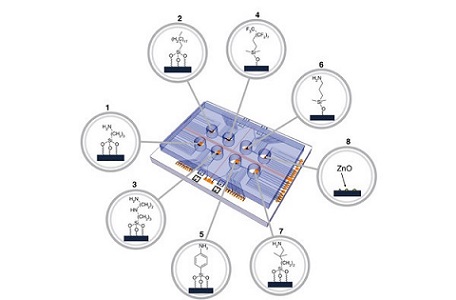Reliable detection of trace amounts of hazardous chemicals, in particular explosives, remains a pervasive problem due to the broad variety of associated chemical compounds that must be monitored in an open environment. In combination with the inherently low vapor pressures of most explosive compounds, the challenges of detecting potential threats require sensing techniques having ultra-high sensitivity, high selectivity, and rapid response. While such performance is available using sophisticated and expensive equipment, the need exists for portable, low cost systems that can discriminate a broad range of chemical species with high sensitivity and low probability of false responses. A broad range of nanomaterials have proven effective for chem/bio detection due to their high surface to volume ratio, thereby providing high sensitivity. Effective probability of detection has been demonstrated for certain trace chemical analysis by chemically functionalizing the nanomaterial surface such that the analyte of interest has an increased affinity to bind with the nanomaterial surface, which changes the electrical properties of the sensor. While this has enabled a pathway for highly sensitive, low cost sensor platforms, chemical selectivity for detection in open environments remains a challenge. For this, the concept of a chemical nose is required that can accurately discriminate trace chemicals in air.
Approaches to chemical nose sensing typically include arrays of nanosensors with different elements of the array having variable properties for binding different chemical species by varying the chemical functionality added to the individual sensors in the array. Subsequent statistical analysis of the sensor array when exposed to various compounds can then provide a specific signature associated with each compound. Establishing a library of signatures makes this approach extendable for identification of a broad range of chemical unknowns. Recently, Lichtenstein, et. al. reported on the demonstration of a chemically modified nanosensor array platform for ultrasensitive detection of explosives . The reported platform consisted of 144 nanosensors arranged into 8 subarrays of 18 nanosensors. Each nanosensor element consisted of a silicon nanowire Field Effect Transistor (FET) device, with each subarray chemically modified with different small molecule receptors for ultrasensitive discrimination of chemical species. Each subarray is fed by a microfluidic channel which controls the flow and interaction of the analyte with the modified sensor array. Detection occurs by first sampling the air for 5 seconds, which is pre-concentrated by flowing through a microporous filter (50-100 l/min), then flushing the adsorbed analyte from the filter membrane using a commercially available explosive standard solution, which subsequently carries the analyte to the nanosensor subarrays.

References: Lichtenstein A, Havivi E, Shacham R, Hahamy E, Leibovich R, Pevzner A, Krivitsky V, Davivi G, Presman I, Elnathan R, Engel Y, Flaxer E, Patolsky F. Supersensitive fingerprinting of explosives by chemically modified nanosensors arrays. Nat. Commun. 5(4195). doi: 10.1038/ncomms5195
Image reprinted with permission from Nature Publishing Group.
